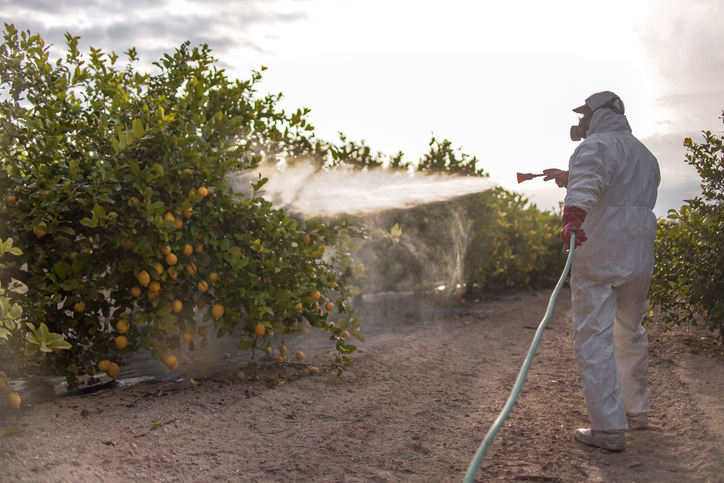Agriculture is one of the main causes of global emissions with about 30% of total global emissions being caused by agricultural activities, including the use of pesticides and other agrochemicals. These harmful chemicals cause many issues in the environment aside from contributing to global emissions, including fish mortality, water pollution, and more. Now more than ever, it is crucial to start implementing agrochemical biodegradable ingredients.
The Environmental Impact of Traditional Agrochemicals
Soil
The bacteria that is naturally found in soil are responsible for creating nitrogen which makes the soil fertile for plants to grow. Agrochemicals can negatively impact the population of these bacteria, reducing the amount of nitrogen in the soil and reducing the overall fertility of the soil. Earthworms also play a vital role in plant irrigation, soil drainage, and aeration. Pesticides and other agrochemicals cause a decline in the earthworm population, leading to increased soil erosion. All of this results in soil that is less fertile and harder to grow crops and plants in.
Air
During the spraying of agrochemicals, the wind can cause them to drift and contaminate nearby surfaces. When exposed, these agrochemicals can have adverse effects on human health, plants, insects, and water bodies. The exposure to agrochemicals can impact pollinators as well, including bees, fruitflies, butterflies, and some beetles. They are very sensitive to agrochemicals and their populations can drop off, reducing the amount of pollination which results in a decrease in plant life.
Water
Agrochemicals commonly make their way into water bodies through air, accidental spills, and rain runoff. This can cause contamination of groundwater with nitrate, which is poisonous to both humans and animals. Additionally, pesticides have been directly linked to fish mortality, which can impact various food chains, disrupting the entire ecosystem.
How Turning to Non-Persistent, Non-Toxic AgrochemicalIngredients Can Help the Environment
While traditional agrochemicals have detrimental effects on the environment, agrochemicals that are biodegradable and non-toxic can reduce these effects. By implementing biodegradable agrochemicals with low toxicity, you can reduce the risk of contaminating soil, air, and water.
These ingredients can quickly break down in common end-of-life environments, preventing them from persisting and causing extensive damage to the environment. Additionally, they don’t contain the harmful chemicals that traditional agrochemicals do, reducing their inherent risk to humans, animals, and the ecosystem as a whole.
How You Can Develop Agrochemical Biodegradable Ingredients
Once you have developed your agrochemical biodegradable ingredients, it is important to test their biodegradability and ecotoxicity. While there are many tests out there, there are three that are particularly beneficial when developing agrochemicals.
OECD 207
This testing method determines the toxicity of your agrochemicals to earthworms. This test contains two methods — the paper contact toxicity test and the artificial soil test.
The initial screening test is the paper contact test. During this method, earthworms are exposed to test substances on moist filter paper to identify potentially toxic chemicals to the earthworms in soil. There are five or more treatment levels in the series and at least ten replicates.
The artificial soil test provides data that is more representative of the natural exposure of earthworms to the chemicals. During this method, the earthworms are kept in defined artificial soil and the test substance is applied in five different concentrations to determine mortality.
OECD 208
OECD 208 tests the effects of seedling emergence and early growth of plants following exposure to the test substance when it is applied to the soil. The seeds are placed in contact with soil that is treated with the test agrochemical and is evaluated for effects 14 to 21 days after 50% emergence of the seedlings in the control group. The endpoints measured include seedling emergence, biomass measurements, shoot height, and visible detrimental effects on parts of the plant.
OECD 301
At Aropha, we offer three OECD 301 tests — OECD 301B, OECD 301D, and OECD 301F. Each of these tests are aqueous aerobic biodegradation tests that determine the ready biodegradability of biodegradable agrochemicals. OECD 301 is used to determine if your agrochemicals are easily biodegradable, but do not test the actual rate of biodegradation.
- OECD 301B measures the CO2 evolution in continuously aerated bottles over the course of 28 days.
- OECD 301D measures the dissolved oxygen consumption during biodegradation in closed bottles over a 28 day period.
- OECD 301F measures the oxygen consumption during biodegradation in closed respirometers.
An agrochemical is considered readily biodegradable if 60% of degradation is reached within a 10-day window. This window must fall within the 28 day period and is defined as beginning when 10% of degradation is reached and ending 10 days from that point.
Test the Biodegradability of Your Agrochemicals at Aropha
At Aropha, we offer various biodegradability tests so you have all of the information you need to continue your research and development processes or pursue biodegradability certification. We also offer digital twin simulation testing with our online platform, ArophaAI. This allows you to gain accurate biodegradability simulation results without having to send your products in for lab testing.
Contact our team today to learn more and to get started.

